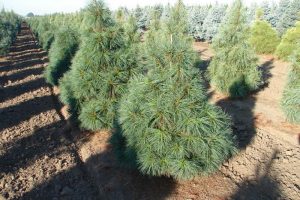Blue Pine
The blue pine is a conifer found in and around South Asia. It was first described by botanist Nathaniel Wallich of the Kolkata Botanical Gardens after whom the binomial name of this tree is given.
Scientific Classification
| Kingdom | Plantae |
| Division | Pinophyta |
| Class | Pinopsida |
| Order | Pinales |
| Family | Pinaceae |
| Genus | Pinus |
| Subgenus | Strobus |
| Scientific Name | Pinus wallichiana |
Quick Information
| Other Names | Bhutan pine, Himalayan pine, Himalayan blue pine, Himalayan white pine, Kail (Hindi), Chilla (Hindi) |
| Tree type | Evergreen |
| Identification | Size: 98-164 ft (30-50 m) Trunk Diameter: Up to a 3.2 ft (1 m) or more Needles (Leaves): Arranged in fascicles of 5, about 4.72-7in (12-18 cm) long, flexible, blue-green in color Bark: Smooth on young trees but become fissured as they age Cones: Long, slender, yellow-buff at maturity, 6.3-12.6 in (16-32 cm), have thin scales Seeds: 0.20-0.24 in (5-6 mm) in length with a 0.79-1.18 in (20-30 mm) wing |
| Distribution | From Afghanistan through Pakistan into India continuing to Tibet, Nepal, Bhutan into Myanmar |
| Habitat | Grows at 5,905-14,107 ft (1,800-4,300 m) in a temperate |
| Hardiness Zones | 5-7 |
| Growth Rate | Fast |
| Lifespan | Oldest recorded tree is 410 years old |
| Growing Conditions | Summer Conditions: Prefers wet summers Winter Conditions: Dry winters Rainfall: 10-80 inches of mean annual rainfall Light: Full sun Soil: Well-drained, moist clay or loamy |
| Diseases & Pests | Cones and seeds susceptible to Dioryctria abietella, bark beetles, Bliston regalis, brown-needle disease and Dothistroma needle blight |
| Reproduction system | Monoecious |
| Propagation | By seeds |
| Seedling Development | Seeds easily germinate and grow |
| Wildlife Value | Many birds nest in this tree |
| Uses | Wood used as firewood but gives off a pungent smoke, it is also a source of tar and turpentine, the latter being a vermifuge, diuretic, antiseptic, and rubefacient, which are medicinal qualities; used as an ornamental tree to augment the aesthetics of gardens |
| IUCN Conservation Status | Least Concern |
Interesting Facts
- The blue pine tree has a high level of resistance to air pollution, being able to withstand it much better than most other coniferous trees.
- In the US, the blue pine can be grown well in places like Roslindale, MA, Lisle, IL, Cincinnati, OH, Ogden, UT, and Federal Way, WA among others.
References:
- http://www.flowersofindia.net/catalog/slides/Himalayan%20Blue%20Pine.html
- https://www.conifers.org/pi/Pinus_wallichiana.php
- https://pfaf.org/user/Plant.aspx?LatinName=Pinus+wallichiana
- https://www.iucnredlist.org/species/42427/2979371
- http://www.missouribotanicalgarden.org/PlantFinder/PlantFinderDetails.aspx?kempercode=c235
- https://davesgarden.com/guides/pf/go/81216/#b
- https://www.greatplantpicks.org/plantlists/view/1209
- https://apps.worldagroforestry.org/treedb/AFTPDFS/Pinus_wallichiana.PDF
- https://www.rhs.org.uk/plants/13150/pinus-wallichiana/details
Published on June 22nd 2017 by Sudipto Chakrabarti under Pine.
Article was last reviewed on 26th June 2023.












Why is it called a BLUE Pine instead of White, Yellow, Black, or Red? What distinguishes it as BLUE????